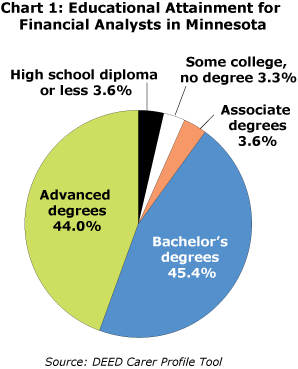by Erik White
May 2016
Although financial analysts are forced to deal with economic uncertainty every day in their forecasts, their own economic future seems very secure. Highly valued for their expertise in providing information and intelligence for decision making, financial analysts are in high demand across both the public and private sectors and are projected to stay that way in the future.
Data from DEED's Occupational Employment Statistics program show there are now more than 6,000 people employed as financial analysts in Minnesota, a 34 percent increase compared to just 10 years ago. Wages have also increased greatly for these occupations over time, climbing to a median wage just over $39 per hour in 2016 or more than $80,000 per year (see Table 1).
| Table 1: Employment and Wages for Financial Analysts in Minnesota, 1st Qtr. 2016 | |||
|---|---|---|---|
| Estimated Regional Employment | Median Hourly Wage | Median Annual Salary | |
| State of Minnesota | 6,020 | $39.05 | $81,224 |
| Twin Cities Metro Area | 5,440 | $39.52 | $82,202 |
| Southeast Minnesota | 270 | $36.27 | $75,442 |
| Central Minnesota | 160 | $37.47 | $77,938 |
| Northwest Minnesota | 80 | $29.99 | $62,379 |
| Southwest Minnesota | 70 | $30.74 | $63,939 |
| Northeast Minnesota | 50 | $35.61 | $74,069 |
| Source DEED Occupational Employment Statistics | |||
Over 90 percent of the state's financial analysts are employed in the seven-county Twin Cities metro area, with smaller numbers of jobs and lower wages spread across the other regions in Greater Minnesota. While Southeast and Central had the next highest wages and number of jobs, wages were lowest in Northwest, and Northeast had the smallest number of jobs.
As access to data improves, more and more institutions are relying on the work of financial analysts for successful decision making. According to employment projections, the state is expected to gain over 300 new financial analysts in the next decade, a 5 percent increase. In addition, there will be more than 1,200 replacement openings available caused by retirements and other career changes, with the greatest number of both new jobs and replacements available in the Twin Cities metro area.
Though somewhat self-explanatory, financial analysts are expected to analyze financial information in order to monitor and forecast industry and economic conditions to help both public and private sector organizations and clients make informed investment decisions. They must be able to communicate highly technical information through reports, visualizations, and presentations that make it easy for decision makers to understand the implications of their choices.
In addition to math and accounting skills, financial analysts must also have excellent written and oral comprehension and communication abilities. The ability to combine pieces of information to form general rules, find relationships among seemingly unrelated events, draw conclusions, and find solutions is vital. Much of the work requires face-to-face discussions and teamwork, but the work is also unstructured and provides freedom to guide and to make decisions.
More than 75 percent of financial analysts in Minnesota are employed in either the Professional and Business Services or Financial Activities industries, and more specifically in five sectors that are more strongly concentrated in the state than the nation. In comparison to the U.S., Minnesota reported a location quotient of 1.3 in Financial Investment Activities, Management of Companies, Securities and Commodities Contracts Intermediation, Depository Credit Intermediation, and Management, Scientific, and Technical Consulting Services, where financial analysts are the most likely to be employed (see Table 2).
| Table 2: Leading Industries for Financial Analysts | ||
|---|---|---|
| Industry | Estimated Employment | Median Wage |
| Professional and Business Services | 2,370 | $40.35 |
| Financial Activities | 2,280 | $37.34 |
| Manufacturing | 450 | $41.16 |
| Education and Health Services | 420 | $38.88 |
| Trade, Transportation, and Utilities | 280 | $37.14 |
| Information | 90 | $41.50 |
| Public Administration | 80 | $39.07 |
| Other Services | 20 | $31.02 |
| Source DEED Occupational Employment Statistics | ||
The distribution of this occupation among leading economic sectors demonstrates the value of quantitative analysis in successful decision making for public and private entities throughout Minnesota's economy. Financial analysts put in long hours researching various subjects, with attention to detail essential in the reports they produce. With this grind come great rewards, however, as financial analysts are compensated with high wages and held in high esteem by the decision makers that utilize them.
With 90 percent of current job holders having a Bachelor's degree or higher, job seekers can't just walk in off the street and become a financial analyst, unless maybe it was Wall Street. The typical education required is a Bachelor's degree, but nearly as many financial analysts have a Master's, PH.D, or professional degree as have Bachelor's degrees (see Chart 1).

Common courses include accounting, banking and financial support services, credit management, economics, investments and securities, financial planning and services, and international and public finance. Mastering technical skills in spreadsheets, data warehousing, and statistical analysis through appropriate software is a must in this competitive field as well.
There are dozens of certifications for financial analysts from dozens of certifying organizations, ranging from Chartered Financial Analyst from the CFA Institute to Qualified Plan Financial Consultant from the American Society of Pension Professionals and Actuaries. These certifications typically require on-the-job experience and passing a series of exams and may also require fees and continuing education.
Because of the wide range of uses for financial analysis, a wide range of alternative job titles for these skillsets includes: banking analyst, bond analyst, budget analyst, commodity analyst, corporate financial analyst, credit products officer, equity research analyst, financial advisor, investment analyst, operational risk analyst, real estate analyst, and securities analyst, among many others. These jobs are in high demand and are expected to stay that way in the future.